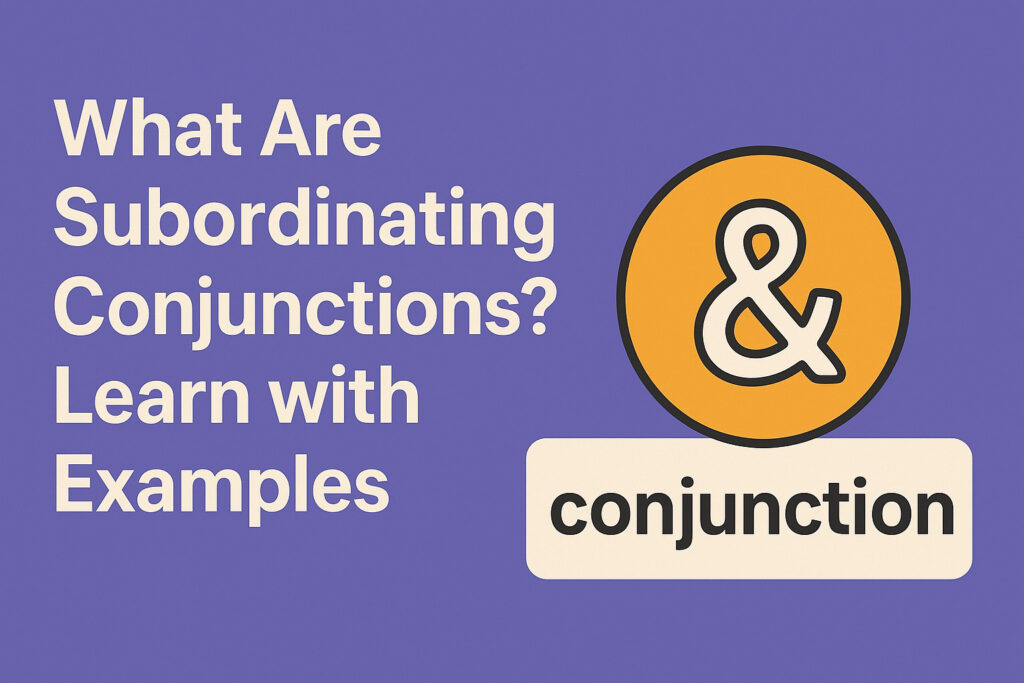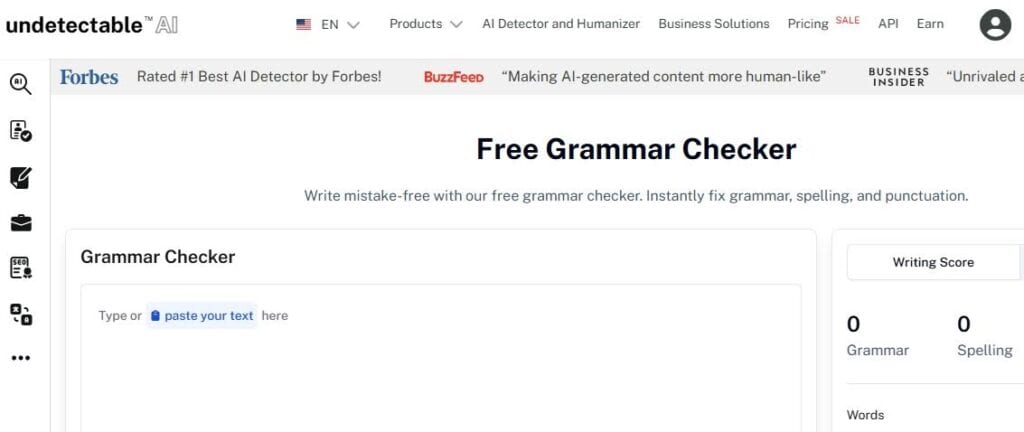Conjunctions are one of the core rules of grammar used for linking words, phrases, and sentences.
There are different types of conjunctions, and each has its own job.
Subordinating conjunctions are the ones that show cause, time, contrast, condition, and more. They turn one idea into a backdrop for another.
In this guide, I’ll discuss what are subordinating conjunctions, when and how to use them, the mistakes to be careful of, and how to level up your writing with AI.
Key Takeaways
- Subordinating conjunctions link a dependent clause to an independent one.
- The most commonly used subordinating conjunctions include because, since, although, so that, while, than, until, etc.
- Subordinating ones create structure by making one clause depend on another. Coordinating conjunctions (FANBOYS), in contrast, join equal ideas.
- You can layer multiple subordinating conjunctions in one sentence to express time, contrast, or conditions all at once
Definition of Subordinating Conjunctions

A subordinating conjunction is just a word that connects a dependent clause to an independent one.
It basically describes when something happens, why it happens, or under what condition to make one part of the sentence rely on the other for full meaning.
It subordinates one clause to another.


Never Worry About AI Detecting Your Texts Again. Undetectable AI Can Help You:
- Make your AI assisted writing appear human-like.
- Bypass all major AI detection tools with just one click.
- Use AI safely and confidently in school and work.
Look at this example sentence: I didn’t go out because it was raining.
In this sentence, the word “because” is the subordinating conjunction.
It introduces the reason for the action, but that second half, i.e, “because it was raining” doesn’t stand on its own. It needs the first part of the sentence to make sense.
Now, just so you’re not thinking subordinating conjunctions are the only game in town, it’s worth knowing that there are two other types of conjunctions.
- Coordinating conjunctions connect two equal parts of a sentence. They don’t make one idea dependent on the other. They just connect them.
- Correlative conjunctions that always come in pairs, like “either/or,” “neither/nor,” and “not only/but also,” show a relationship between two ideas.
If you ever find yourself unsure about what type of conjunction you’re dealing with, simply run the sentence through Undetectable AI’s Ask AI.

It will tell you whether your conjunction is subordinating, coordinating, or correlative.
List of Common Subordinating Conjunctions
There’s no shortage of subordinating conjunctions in English, but some get used way more often than others.
Here’s a subordinating conjunctions list classified by the purpose of the conjunctions:
- Time (when something happens): after, before, when, whenever, while, as soon as, until, once, as long as
- Cause and Effect (why something happens): because, since, as, in order that, so that, now that
- Condition (under what condition something happens): if, unless, even if, provided that, in case, only if
- Contrast/Concession (unexpected twist or contradiction): although, though, even though, whereas, while (when it means “although”), rather than
- Purpose (intended result or goal): so that, in order that, that (when used with intent: “She whispered so that no one would hear.”)
- Comparison or Manner (how something happens or is compared): than, as if, as though
- Place (where something happens): where, wherever
How to Use Subordinating Conjunctions in Sentences
Knowing what subordinating conjunctions are is one thing.
Actually using them in complex sentences without making a mess needs a little more intention.
There are two ways to use a subordinating conjunction in a sentence:
- If you want your sentence to lead with a reason, contrast, or condition, start with the subordinating conjunction and follow it up with the main clause. It, however, requires a comma after the first clause.
Example:
“Because I forgot to set an alarm, I missed my flight.”
“Although she hates running, she still shows up every morning.”
- You can start with the main clause and follow with the dependent clause if the supporting detail isn’t the focus of the sentence. No comma is needed in this structure.
Example:
“I missed my flight because I forgot to set an alarm.”
“She still shows up every morning, although she hates running.”
Even if you understand the structure, it’s easy to overlook tiny errors.
When you’re new to using subordinating conjunctions in sentences, always use an AI Grammar Checker to catch any subtle grammar or punctuation errors.

Subordinating vs Coordinating Conjunctions
Now that you’ve got a handle on what subordinating conjunctions are and seen plenty of subordinating conjunctions examples, it’s time to look at how they differ from coordinating conjunctions.
Both play the role of linking ideas, but they don’t do it the same way.
Hierarchical vs Equal Relationships
At the core, subordinating conjunctions create a hierarchy between ideas.
One part of the sentence becomes dependent on the other for full meaning.
The clause that follows the subordinating conjunction can’t stand on its own.
For example: “Even though he practiced every day, he still missed the final shot.”
“Even though he practiced every day” is an incomplete sentence on its own. It sets up an expectation that needs resolution. That’s because subordinating conjunctions push one part of the sentence into the supporting role and the other into the main spotlight.
Now compare that to coordinating conjunctions, which connect two equal ideas, both grammatically and in meaning.
If you say, “I stayed home, and I watched movies,” both parts here are self-contained. You could easily split them into two separate sentences, and they’d still work just fine.
FANBOYS vs Subordinating Use Cases
There’s a handy trick to remember the coordinating conjunctions, the acronym FANBOYS. Research says that the FANBOY (without the S) mnemonic first appeared in a 1951 book titled ‘Learning to Write’ by Smith, Paxton, and Meserve.
It stands for:
- For
- And
- Nor
- But
- Or
- Yet
- So
These seven are the core set, and they’re used to connect words, phrases, or full sentences that are of equal grammatical weight.
Subordinating conjunctions, on the other hand, are a larger and more varied group.
You’ve already seen their list earlier.
These aren’t just used to glue two ideas together. Instead, they explain how one idea connects to another in terms of time, reason, contrast, purpose, or condition.
Side-by-Side Sentence Comparisons
The best way to see the difference between subordinating vs coordinating conjunctions is to lay two sentences side by side.
Look at how swapping the type of conjunction shifts the focus of the sentence:
- Coordinating: “She wanted to travel, but she stayed home.”
(You’re connecting two equal thoughts. The “but” signals contrast, but it doesn’t make one thought depend on the other.)
- Subordinating: “Although she wanted to travel, she stayed home.”
(Now her desire to travel becomes a background condition. The focus is on the fact that she stayed home despite that desire.)
The difference in the type of conjunction used affects how your writing flows and how readers process your meaning.
Common Mistakes and How to Fix Them
Here’s a breakdown of the most common slip-ups while using subordinating conjunctions and how to clean them up.
- Starting a sentence with a subordinating conjunction, then leaving it hanging: People often start with a subordinating conjunction but forget to follow up with the main clause.
- Misplacing the comma: When the subordinating clause comes before the main clause, you need a comma. But if it comes after, you don’t. These punctuation errors can be penalized if you’re writing anything academic.
- Overcomplicating sentences with too many subordinating clauses: It’s tempting to pile on clauses when you’re trying to sound thorough. But using too many subordinating conjunctions in a single sentence confuses your reader and buries your main point.
In a research conducted on student’s use of subordinating conjunctions, students especially had trouble using the words as, in case, because, and since, when forming complex sentences.
It is always wise to run your sentences through Undetectable AI’s AI Humanizer to ensure you smooth out stiff or mechanical transitions.

It’ll fix improper clause structure and make sure your subordinating clauses don’t accidentally hijack your tone.
Advanced Uses of Subordinating Conjunctions

Most grammar lessons of subordinating conjunctions stop at basic cause-and-effect examples.
However, they are capable of a lot more when you start layering them intentionally.
Let’s look at three advanced ways to take subordinating conjunctions beyond the basics.
- Multiple Clauses in a Single Sentence
One of the most useful moves is combining more than two clauses in a sentence, sometimes using more than one subordinating conjunction.
It lets you build complex, layered thoughts without having to chop them into a bunch of short and choppy lines.
For example, “Although the forecast predicted sun, we canceled the hike because the sky was already darkening.”
Here, “Although the forecast predicted sun” sets up a contrast, and “because the sky was already darkening” explains the reason for the action.
Both subordinating conjunctions are doing different jobs, and they each cue the reader to shift context slightly.
You can also do this with conditional logic: “If you finish your work early because the new software speeds things up, we might have time to review the project today.”
This sentence mixes a condition (“if”) with a cause (“because”), which sounds natural but packs in a lot of detail.
- Combining Contrast + Time or Condition
You can use subordinating conjunctions to show two kinds of relationships at the same time. One part of the sentence introduces contrast, i.e., something unexpected or surprising.
Another part introduces time as to when something happens or the condition under which it happens.
Here’s an example: “Although she had the flu, she stayed at work until 5 p.m.”
Now, let’s dissect this sentence:
- “Although she had the flu” shows the contrast. Normally, you’d expect someone with the flu to go home, but she didn’t.
- “Until 5 p.m.” adds a time detail, i.e., how long she powered through.
So in a single line, you show both something surprising and when it happened. You didn’t need to say, “She had the flu. But she stayed at work. She left at 5.”
You used subordination to weave it all into one tighter, smoother sentence.
- Varying Sentence Openers for Style
Subordinating conjunctions let you mix up your sentence rhythm and avoid that flat, repetitive structure where everything starts with the subject.
Starting a sentence with a subordinating clause adds variety to your tone without needing fancy vocabulary or wild sentence length.
For example, “Because I was leaving, I turned off the lights.”
or, “Although the deadline was tight, we managed to submit early.”
Such openers create a little narrative hook.
They give context first and let the reader process the situation before getting to the result. It’s very useful in creative writeups, like storytelling or essays.
Maintain credibility and clarity—leverage our AI Detector and Humanizer below.
Final Thoughts
The only real way to get good at subordinating conjunctions, or any grammar tool, really, is to use them in real, everyday sentences.
Start noticing how people use them in conversation and how they show up in articles.
Then practice, do short drills to reinforce your learning.
If you want custom worksheets tailored to your weak spots, run a few of your sentences through Ask AI. It can generate exercises just for you and flag any grammar slips along the way.
Start small and stay consistent, and with Undetectable AI as your study partner, you’ll be a pro at using subordinating conjunctions.
